
The ampere, often shortened to amp, is the unit of electric current in the International System of Units (SI). One ampere is equal to 1 coulomb (C) moving past a point per second. It is named after French mathematician and physicist André-Marie Ampère (1775–1836), considered the father of electromagnetism along with Danish physicist Hans Christian Ørsted.
The General Conference on Weights and Measures is the supreme authority of the International Bureau of Weights and Measures (BIPM), the intergovernmental organization established in 1875 under the terms of the Metre Convention through which member states act together on matters related to measurement science and measurement standards. The CGPM is made up of delegates of the governments of the member states and observers from the Associates of the CGPM. It elects the International Committee for Weights and Measures as the supervisory board of the BIPM to direct and supervise it.

The kilogram is the base unit of mass in the International System of Units (SI), having the unit symbol kg. It is a widely used measure in science, engineering and commerce worldwide, and is often simply called a kilo colloquially. It means 'one thousand grams'.

The Metre Convention, also known as the Treaty of the Metre, is an international treaty that was signed in Paris on 20 May 1875 by representatives of 17 nations: Argentina, Austria-Hungary, Belgium, Brazil, Denmark, France, Germany, Italy, Peru, Portugal, Russia, Spain, Sweden and Norway, Switzerland, Ottoman Empire, United States of America, and Venezuela.

The International System of Units, internationally known by the abbreviation SI, is the modern form of the metric system and the world's most widely used system of measurement. Coordinated by the International Bureau of Weights and Measures it is the only system of measurement with official status in nearly every country in the world, employed in science, technology, industry, and everyday commerce.

The mole (symbol mol) is a unit of measurement, the base unit in the International System of Units (SI) for amount of substance, a quantity proportional to the number of elementary entities of a substance. One mole contains exactly 6.02214076×1023 elementary entities (approximately 602 sextillion or 602 billion times a trillion), which can be atoms, molecules, ions, ion pairs, or other particles. The number of particles in a mole is the Avogadro number (symbol N0) and the numerical value of the Avogadro constant (symbol NA) expressed in mol-1. The value was chosen on the basis of the historical definition of the mole as the amount of substance that corresponds to the number of atoms in 12 grams of 12C, which made the mass of a mole of a compound expressed in grams, numerically equal to the average molecular mass or formula mass of the compound expressed in daltons. With the 2019 revision of the SI, the numerical equivalence is now only approximate but may be assumed for all practical purposes.

The caesium standard is a primary frequency standard in which the photon absorption by transitions between the two hyperfine ground states of caesium-133 atoms is used to control the output frequency. The first caesium clock was built by Louis Essen in 1955 at the National Physical Laboratory in the UK and promoted worldwide by Gernot M. R. Winkler of the United States Naval Observatory.

The Avogadro constant, commonly denoted NA or L, is an SI defining constant with an exact value of 6.02214076×1023 mol−1 (reciprocal moles). It is defined as the number of constituent particles (usually molecules, atoms, ions, or ion pairs) per mole (SI unit) and used as a normalization factor in the amount of substance in a sample. In the SI dimensional analysis of measurement units, the dimension of the Avogadro constant is the reciprocal of amount of substance, denoted N−1. The Avogadro number, sometimes denoted N0, is the numeric value of the Avogadro constant (i.e., without a unit), namely the dimensionless number 6.02214076×1023; the value chosen based on the number of atoms in 12 grams of carbon-12 in alignment with the historical definition of a mole. The constant is named after the Italian physicist and chemist Amedeo Avogadro (1776–1856).
The dalton or unified atomic mass unit is a unit of mass defined as 1/12 of the mass of an unbound neutral atom of carbon-12 in its nuclear and electronic ground state and at rest. It is a non-SI unit accepted for use with SI. The atomic mass constant, denoted mu, is defined identically, giving mu = 1/12m(12C) = 1 Da.

The metric system is a decimal-based system of measurement. The current international standard for the metric system is the International System of Units, in which all units can be expressed in terms of seven base units: the metre (m), kilogram (kg), second (s), ampere (A), kelvin (K), mole (mol), and candela (cd). These can be made into larger or smaller units with the use of metric prefixes.
A base unit of measurement is a unit of measurement adopted for a base quantity. A base quantity is one of a conventionally chosen subset of physical quantities, where no quantity in the subset can be expressed in terms of the others. The SI base units, or Systéme International d'unités, consists of the metre, kilogram, second, ampere, kelvin, mole and candela.

Metrology is the scientific study of measurement. It establishes a common understanding of units, crucial in linking human activities. Modern metrology has its roots in the French Revolution's political motivation to standardise units in France when a length standard taken from a natural source was proposed. This led to the creation of the decimal-based metric system in 1795, establishing a set of standards for other types of measurements. Several other countries adopted the metric system between 1795 and 1875; to ensure conformity between the countries, the Bureau International des Poids et Mesures (BIPM) was established by the Metre Convention. This has evolved into the International System of Units (SI) as a result of a resolution at the 11th General Conference on Weights and Measures (CGPM) in 1960.
The metre, kilogram, second system of units, also known more briefly as MKS units or the MKS system, is a physical system of measurement based on the metre, kilogram, and second (MKS) as base units. Distances are described in terms of metres, mass in terms of kilograms and time in seconds. Derived units are defined using the appropriate combinations, such as velocity in metres per second. Some units have their own names, such as the newton unit of force which is the combination kilogram metre per second squared.
A conventional electrical unit is a unit of measurement in the field of electricity which is based on the so-called "conventional values" of the Josephson constant, the von Klitzing constant agreed by the International Committee for Weights and Measures (CIPM) in 1988, as well as ΔνCs used to define the second. These units are very similar in scale to their corresponding SI units, but are not identical because of the different values used for the constants. They are distinguished from the corresponding SI units by setting the symbol in italic typeface and adding a subscript "90" – e.g., the conventional volt has the symbol V90 – as they came into international use on 1 January 1990.

The kelvin is the base unit for temperature in the International System of Units (SI). The Kelvin scale is an absolute temperature scale that starts at the lowest possible temperature, taken to be 0 K. By definition, the Celsius scale and the Kelvin scale have the exact same magnitude; that is, a rise of 1 K is equal to a rise of 1 °C and vice versa, and any temperature in degrees Celsius can be converted to kelvin by adding 273.15.

The International Prototype of the Kilogram is an object whose mass was used to define the kilogram from 1889, when it replaced the Kilogramme des Archives, until 2019, when it was replaced by a new definition of the kilogram based entirely on physical constants. During that time, the IPK and its duplicates were used to calibrate all other kilogram mass standards on Earth.

In 2019, four of the seven SI base units specified in the International System of Quantities were redefined in terms of natural physical constants, rather than human artefacts such as the standard kilogram. Effective 20 May 2019, the 144th anniversary of the Metre Convention, the kilogram, ampere, kelvin, and mole are now defined by setting exact numerical values, when expressed in SI units, for the Planck constant, the elementary electric charge, the Boltzmann constant, and the Avogadro constant, respectively. The second, metre, and candela had previously been redefined using physical constants. The four new definitions aimed to improve the SI without changing the value of any units, ensuring continuity with existing measurements. In November 2018, the 26th General Conference on Weights and Measures (CGPM) unanimously approved these changes, which the International Committee for Weights and Measures (CIPM) had proposed earlier that year after determining that previously agreed conditions for the change had been met. These conditions were satisfied by a series of experiments that measured the constants to high accuracy relative to the old SI definitions, and were the culmination of decades of research.

The history of the metric system began during the Age of Enlightenment with measures of length and weight derived from nature, along with their decimal multiples and fractions. The system became the standard of France and Europe within half a century. Other measures with unity ratios were added, and the system went on to be adopted across the world.

The following outline is provided as an overview of and topical guide to the metric system:

The scientific community examined several approaches to redefining the kilogram before deciding on a revision of the SI in November 2018. Each approach had advantages and disadvantages.



















